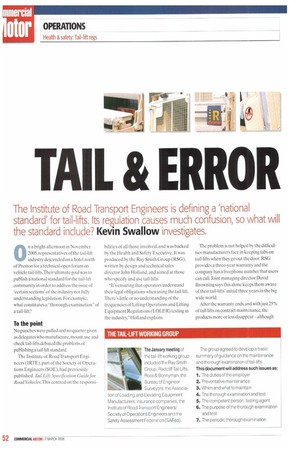TAIL 8i ERROR The Institute of Road Transport Engineers is defining a 'national
Page 52

Page 53

If you've noticed an error in this article please click here to report it so we can fix it.
standard' for tail-lifts. Its regulation causes much confusion, so what will the standard include? Kevin Swallow investigates.
On a bright afternoon in November 2005, representatives of the tail-lift industry descended on a hotel north of Preston for a technical open forum on vehicle tail-lifts.Their ultimate goal was to publish a national standard for the tail-lift community in order to address the issue of 'certain sections' of the industry not fully understanding legislation. For example. what constitutes a "thorough examinationof a tail-lift?
To the point No punches were pulled and no quarter given as delegates who manufacture, mount. use and check tail-lifts debated the problems of publishing a tail-lift standard.
The Institute of Road Transport Engineers (IRTE), part of the Society of Operations Engineers (SOE), had previously published Tail Lift: Specification Guide for Road Vehicles. This centred on the responsi bilities of all those involved, and was backed by the Health and Safety Executive. It was produced by the Ray Smith Group (RSG), written by design and technical sales director John Holland. and aimed at those who specify and use tail-lifts.
"It's ensuring that operators understand their legal obligations when using the tail-lift. There's little or no understanding of the frequencies of Lifting Operations and Lifting Equipment Regulations (LOLER) testing in the industry," Holland explains. The problem is not helped by the difficulties manufacturers face in keeping tabs on tail-lifts when they go out the door. RSG provides a three-year warranty and the company has a freephone number that users can call. Joint managing director David Browning says this alone keeps them aware of their tail-lifts' initial three years in the big wide world.
After the warranty ends, and with just 25% of tail-lifts on contract maintenance, the products more or less disappear although some crop up through a pay-as-you-use scheme for maintenance and LOLER testing. -Bodybuilders in particular are notorious for not telling you what they've done with them," Browning says. He adds that often the literature on the product doesn't make it to the truck on which the tail-lift is fitted.
Manufacturers and bodybuilders will maintain what they have built, but tail-lifts tend to get left out of the loop.
This brings us back to the forum in Preston and the issue of how to raise awareness of the industry's legal obligations.
Long list
I he problems are evident: numerous manufacturers producing countless products; not enough basic design structures for a 'standard"; working tail-lifts in the field having no manual; no universal qualification for inspectors and maintenance crews; questions over the use of weight testing and its limits; a lack of agreed maintenance periods; and the issue of risk assessment. As Holland admits, the November meeting resulted in nothing concrete —but it did provide an important stepping stone towards the January meeting of a small working group that was horn from its ashes (see panel, left).
1RTE/SOE head of technical services Ian Chisholm explains the purpose of the group: "Users and owners have a legal responsibility to ensure a tail-lift is used correctly by trained operatives, and is inspected, maintained and thoroughly examined in accordance with current regulations.
"The aim of the forthcoming guide is to provide information to all parties on the legal responsibilities and requirements concerning the safe use of tail-lifts and compliance with legislation.
"The 1RTE, professional sector of SOE, in consultation with relevant industry organisations. is committed to developing guidance, which it is hoped will result in improved safety for all those involved with the inspection, maintenance and thorough examination of all vehicle tail-lifts." •
















































































































































































































